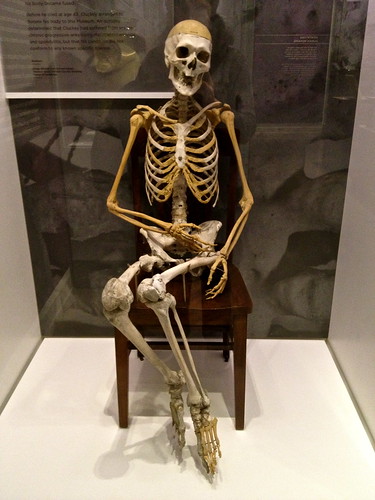
[embedded photo: Peter Cluckey by meanlouise,on Flickr]
Long long ago, when I was a spry and healthy college student, I spent a semester as an intern/volunteer at the National Museum of Health and Medicine, then part of the Armed Forces Institute of Pathology at Walter Reed. When I went to the museum, I always stopped in the exhibit hall to say hi to Peter Cluckey (pictured, above) before going back to the collections area to meet with my supervisor.
Why Peter and not the live leeches or the trichobezoar or the skeleton of Ham the Space Chimp or any of the other interesting objects on display? I find it difficult to explain, but I think you’d understand if you met him.
I always thought it charming and noble that Peter chose to donate his bones to science even though science hadn’t exactly come through for him. The guy spent half his life sitting in a wooden chair (or laying down in the same position), you’d think he wouldn’t want to spend eternity that way. There’s an admirable optimism in his bequest, if you think about it. Plus, he had fascinating skeletal pathology. He didn’t foretell the future to me or anything like that. He was a Spanish American War veteran. He was kinda old when he died and he had an obscure disease, after all.
Cluckey died on Sept. 10, 1925 at the age of 43. He was so impressed with the significance of his disease and the inability of the medical doctors of the time to comprehend the disease and cope with it, that he gave his body to the Army Medical Museum (the progenitor of today’s National Museum of Health and Medicine) for study. Doctors determined during the autopsy that Cluckey had suffered from chronic progressive ankylosing rheumatoid arthritis and spondylitis severe enough to render him completely helpless.
I didn’t visit Peter for years. After September 11 it became inconvenient to gain entry to the museum because it was in the middle of a military installation. Then there was the BRAC, which led to the closure of Walter Reed and the creation of a fancy new museum in Silver Spring, Maryland.
Last week, Husband and I were headed to Philadelphia to visit the Mutter Museum, the oldest medical history museum and research center in the U.S. After about 45 minutes in the car it became apparent to me that a road trip was not in the cards.
Ironically, it was my aching arthritic back and neck that led us to Peter’s door. We decided to visit the new NMHM since we were practically in the neighborhood. According to google maps, anyway. Applemaps probably would have sent us to one of those spooky cornfields the USDA has out in Greenbelt. If we were lucky…
The new museum is smaller and more focused than the old one. Suffice to say that many of the items that were on display in the larger facility are now in storage. I was happy to reach the end of an exhibit and encounter Peter sitting in his chair, as if watching the world go by. I was a bit disturbed to realize I’m not far from Peter’s age now, but I decided not to dwell on that. You should find time to visit the museum.
Remember to stop and say hi to Peter when you’re there and do give him my regards.

[embedded photo: Peter Cluckey]
——–
A trichobezoar is a human hairball. I figured if I gave you that link in the post you’d click it and never come back.
I am equally intrigued and repulsed by the trichobezoar web site. How. Totally. Bizarre.